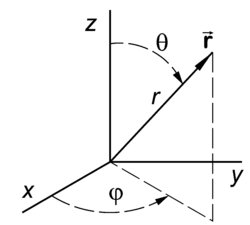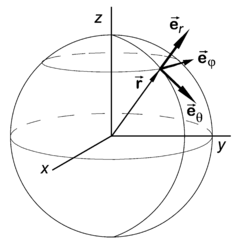Spherical polar coordinates
In mathematics and physics, spherical polar coordinates (also known as spherical coordinates) form a coordinate system for the three-dimensional real space . Three numbers, two angles and a length specify any point in . The two angles specify the position on the surface of a sphere and the length gives the radius of the sphere.
Spherical polar coordinates are useful in cases where there is (approximate) spherical symmetry, in interactions or in boundary conditions (or in both). In such cases spherical polar coordinates often allow the separation of variables simplifying the solution of partial differential equations and the evaluation of three-dimensional integrals.
Definition
Let x, y, z be Cartesian coordinates of a vector in , that is,
where are unit vectors along the x, y, and z axis, respectively. The x, y, and z axes are orthogonal and so are the unit vectors along them.
The length r of the vector is one of the three numbers necessary to give the position of the vector in three-dimensional space. By applying twice the theorem of Pythagoras we find that r2 = x2 + y2 + z2.
Let θ be the colatitude angle (see the figure) of the vector . In the usual system to describe a position on Earth, latitude has its zero at the equator, while the colatitude angle, introduced here, has its zero at the "North Pole". That is, the angle θ is zero when is along the positive z-axis. The sum of latitude and colatitude of a point is 900; these angles being complementary explains the name of the latter. The colatitude angle is also called polar or zenith angle in the literature.
The angle φ gives the angle with the x-axis of the projection of on the x-y plane. The angle φ is the longitude angle (also known as the azimuth angle).
Note that the projection has length r sinθ. The length of the projection of on the x and y axis is therefore r sinθcosφ and r sinθsinφ, respectively. In summary, the spherical polar coordinates r, θ, and φ of are related to its Cartesian coordinates by
Given a spherical polar triplet (r, θ, φ) the corresponding Cartesian coordinates are readily obtained by application of these defining equations.
The figure makes clear that 00 ≤ φ ≤ 3600, 00 ≤ θ ≤ 1800, and r > 0. The coordinate surfaces are:
- r constant, all θ and φ: surface of sphere.
- θ constant, all r and φ: surface of a cone.
- φ constant, all r and θ: plane.
The computation of spherical polar coordinates from Cartesian coordinates is somewhat more difficult than the converse, due to the fact that the spherical polar coordinate system has singularities, also known as points of indeterminacy. The first such point is immediately clear: if r = 0, we have a zero vector (a point in the origin). Then θ and φ are undetermined, that is to say, any values for these two parameters will give the correct result x = y = z = 0. Compare this to the case that one of the Cartesian coordinates is zero, say x = 0, then the other two coordinates are still determined (they fix a point in the yz-plane). Two other points of indeterminacy are the "North" and the "South Pole", θ = 00 and θ = 1800, respectively (while r ≠ 0). On both poles the longitudinal angle φ is undetermined.
So, when going from Cartesian coordinates to spherical polar coordinates, one has to watch for the singularities, especially when the transformation is performed by a computer program. Given x, y and z, the consecutive steps are
Other convention
The convention introduced above (θ for the colatitude angle, φ for the azimuth angle) is used universally in physics. In mathematics—especially in the older and the European literature—it is very widespread, too. To quote a few prestiguous mathematical books that apply it: Abramowitz and Stegun[1] (p. 332), Whittaker and Watson[2] (p. 391), Courant and Hilbert[3] (p.195), and Kline[4] (p. 527). Until the 1960s this convention was used universally, also in mathematical textbooks, see e.g. the 1959 edition of Spiegel[5] (p. 138).
Somewhere in the 1960s it became custom in American mathematical textbooks to use a convention in which φ and θ are interchanged, see e.g. Kay[6] (p. 24) and Apostol[7] (p. 419). This was done for a rather unconvincing pedagogical reason, as can be gathered from the following quotation of Eric Weisstein:
In this work, following the mathematics convention, the symbols for the radial, azimuth, and zenith coordinates are taken as r, θ, and φ, respectively. Note that this definition provides a logical extension of the usual polar coordinates notation, with θ remaining the angle in the xy-plane and φ becoming the angle out of that plane. The sole exception to this convention in this work is in spherical harmonics, where the convention used in the physics literature is retained (resulting, it is hoped, in a bit less confusion than a foolish rigorous consistency might engender).
In more advanced treatises—also American—on spherical functions the old convention remains in use, see e.g. Miller[8] (p. 164). The swapping of θ and φ can only be called unfortunate, because it meant a break with the existing mathematics and physics literature, and since there exists an obvious pedagogical alternative, namely, call the angle, which appears in the 2-dimensional polar coordinates, φ instead of θ.
The convention, which calls the angle between the vector, whose coordinates are described, and the z-axis φ, is followed by the Maple algebraic program package and also by the numerical package Matlab. (Matlab also redefines the zero of the colatitude angle to be on the equator). The Mathematica package follows the convention that has θ as the angle between the vector and the z-axis.
Unit vectors
We will define algebraically the orthogonal set (a coordinate frame) of spherical polar unit vectors depicted on the right. In order to do this, we note that the spherical polar angles are two of the three Euler angles that describe any rotation of .
Indeed, start with a vector along the z-axis, rotate it around the z-axis over an angle φ. Perform the same rotation on the x, y, z coordinate frame. This rotates the x and y axis over a positive angle φ. The y axis goes to the y'-axis. Rotate then the vector and the new frame over an angle θ around the y'-axis. The vector that was initially on the z-axis is now a vector with spherical polar angles θ and φ with respect to the original (unrotated) frame. In formula
where the rotation matrices are defined by
By direct matrix multiplication the matrix expression for the spherical polar coordinates of is easily verified—it could have been postulated without reference to Euler rotations and proved by verification.
We now introduce the coordinate frame depicted in the figure on the right:
That is, the new frame, depicted in the figure, is related to the old frame along the x, y, and z axes by rotation,
Apparently is along . Since the two rotation matrices are orthogonal (have orthonormal rows and columns), the new frame is orthogonal. Since the two rotation matrices have unit determinant (are proper rotations), the new frame is right-handed.
Recall, parenthetically, that free parallel vectors have the same coordinate triplet without respect to a given coordinate frame. Or, equivalently, coordinate frames may be freely translated in a parallel manner. That is, the frame in the figure could have been drawn equally well with its origin in the crossing of the x, y, and z axes, which, however, would have obscured the fact that and are tangent to the surface of the sphere.
Metric tensor
In curvilinear coordinates q i the metric tensor with elements g ij defines an infinitesimal distance,
The Cartesian metric tensor is the identity matrix and hence in Cartesian coordinates,
Consider the following expression between differentials,
with the Jacobi matrix, which is obtained by application of the chain rule, having the following form,
By inspection it follows that
The columns of are orthogonal and normalized (to unity) vectors. Hence the columns of the Jacobi matrix are orthogonal, but not normalized. The inverses of the normalization factors are on the diagonal of the diagonal matrix on the right. These inverse normalization factors are known as scale factors or Lamé factors. Usually they are denoted by h. Hence the spherical polar scale factors are
The infinitesimal distance can be written as follows
where we used that the rotation matrices are orthogonal (matrix times its transpose gives the identity matrix), so that
Hence we find
The spherical polar metric tensor is diagonal (one expresses this by stating that the spherical polar coordinate system is orthogonal) and has the square of the respective scale factors on the diagonal.
Differential operators
(To be continued)
References
- ↑ M. Abramowitz and I. A. Stegun, Handbook of Mathematical Functions, Dover, New York (1965)
- ↑ E. T. Whittaker and G. N. Watson, A Course of Modern Analysis, Cambridge UP, Cambridge UK (1965).
- ↑ R. Courant and D. Hilbert, Methoden der mathematischen Physik I, Springer Verlag, Berlin (1968).
- ↑ M. Kline, Mathematical Thought from Ancient to Modern Times, Oxford UP, New York (1972)
- ↑ M. R. Spiegel, Vector Analysis, Schaum Publishing Company, New York (1959).
- ↑ D. C. Kay, Tensor Calculus, Schaum's outline series, McGraw-Hill, New York (1988)
- ↑ T. M. Apostol, Mathematical Analysis, Addison-Wesley, Reading Mass. (1974)
- ↑ W. Miller, Jr., Symmetry and Separation of Variables, Addison-Wesley, Reading Mass. (1977)

























![{\displaystyle \left[\mathbb {R} _{z}(\phi )\mathbb {R} _{y}(\theta ){\begin{pmatrix}r&0&0\\0&r\sin \theta &0\\0&0&1\\\end{pmatrix}}\right]^{T}\mathbb {R} _{z}(\phi )\mathbb {R} _{y}(\theta ){\begin{pmatrix}r&0&0\\0&r\sin \theta &0\\0&0&1\\\end{pmatrix}}={\begin{pmatrix}r^{2}&0&0\\0&r^{2}\sin ^{2}\theta &0\\0&0&1\\\end{pmatrix}}}](https://wikimedia.org/api/rest_v1/media/math/render/svg/9e09d35b6b180fd9d48b279c708f99ec46cad492)
